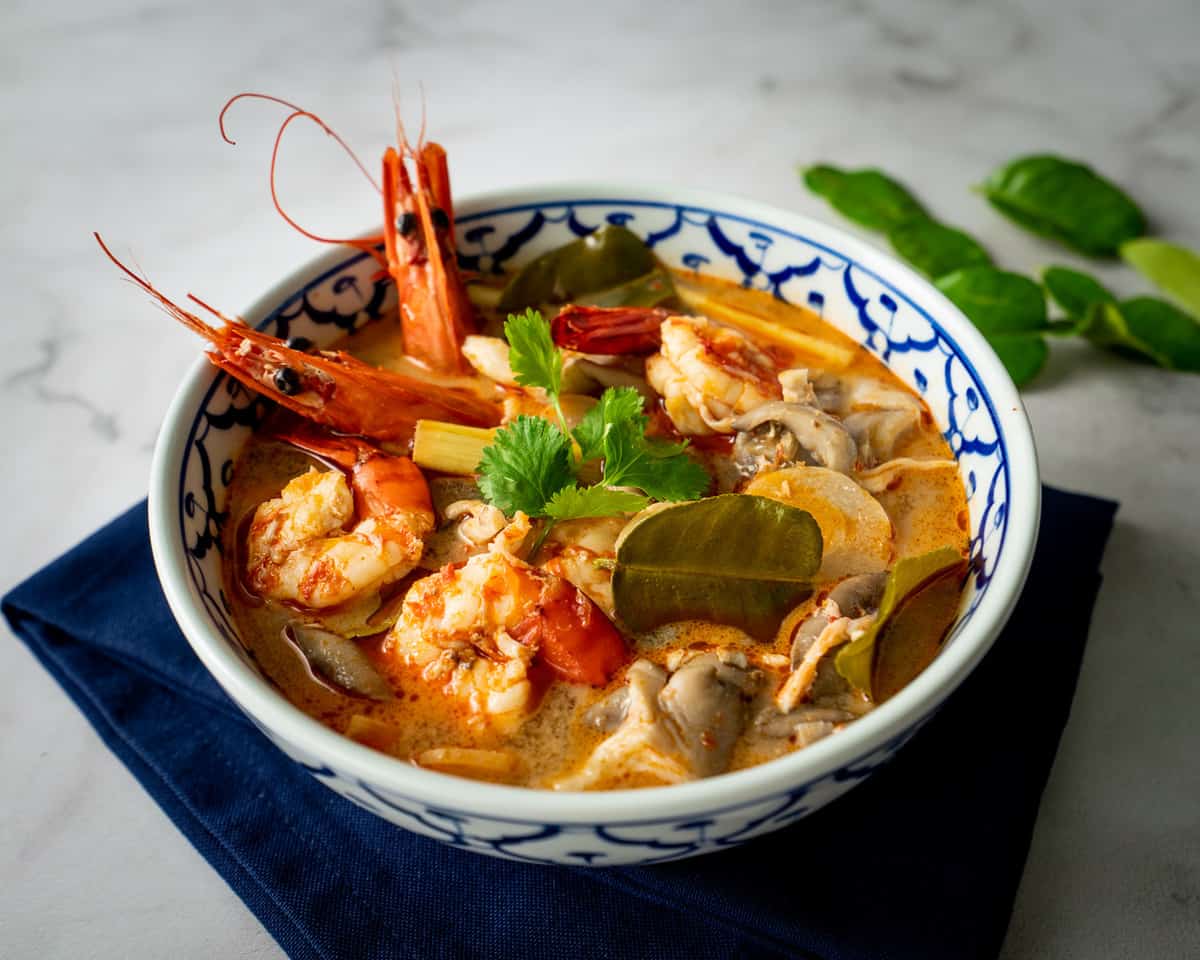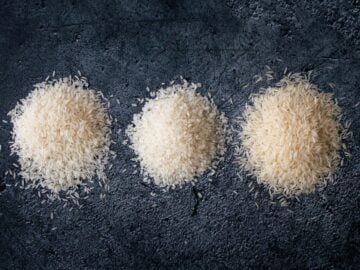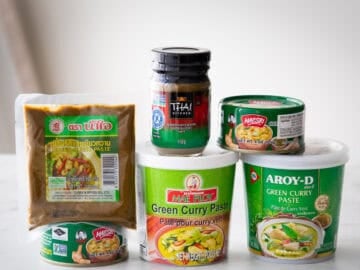Makrut lime leaves, also known as kaffir lime leaves, are an integral part of Thai cuisine. It's a common ingredient that Thai people have in our kitchens, and is crucial in many famous Thai dishes such as tom yum goong, tom kha gai and panang curry. It's also my favourite Thai herb! Its fresh, citrusy aroma is unlike any other citrus fruits, and it can liven up any dish it's added to.
Over the years I've gotten a lot of questions about makrut lime leaves, so in this article I'll cover everything you need to know to cook with them including how to use, choose, store and substitute.

Video: Makrut Lime Leaves 101
If you prefer to watch, everything that's covered in this article is covered in this video, plus you will get to see me demonstrate how to prepare and store them.
Jump to:
- Video: Makrut Lime Leaves 101
- Is it Makrut Lime or Kaffir Lime?
- What is a Makrut Lime?
- Fun Fact: Makrut Lime for Your Hair
- How to Cook with Makrut Lime Leaves
- Is that one leaf or 2 leaves?
- Tip: Watch out for those thorns!
- Buying Makrut Lime Leaves - Fresh, Frozen, and Dried
- How to store makrut lime leaves
- Substitutes for Makrut Lime Leaves
- Recipes with Makrut Lime Leaves
Is it Makrut Lime or Kaffir Lime?
First and most importantly, we need to clarify the name of this herb. Makrut and kaffir limes refer to the same plant. Previously, "kaffir lime" was the most common English name, but because the word "kaffir" happens to sound the same as a racially derogatory term in South Africa, its use has been discouraged in favour of its Thai name makrut. (Note that the plant was not named after the derogatory term; they have different roots. You can read more about in this National Geographic article.)
In my recipe writing, I have switched over to using makrut in the past few years, but older recipes on the website may still have the old name which I try to update as I come across them. But because I am an educator of Thai cooking, it's important for me to educate people on both these names because in most Asian grocery stores today, the leaves and fruits are still being labeled as kaffir, which can cause confusion when people are shopping if they're not aware.
What is a Makrut Lime?

Makrut lime is a type of citrus fruits native to Thailand. It has fruits that are green, about the size of a golf ball, and has bumps on the skin which make them look a bit like a cartoon brain!
The leaves and the zest have very similar aroma to each other, so for Thai cooking, we mostly use just the leaves because they're so much more abundant and easier to use. We do use the zest in situations where we want to incorporate it into a fine paste, such as in red curry paste, because the leaves are tough and much harder to grind down.
Makrut lime juice, on the other hand, is not used much as makrut limes do not have much juice to offer, have lots of seeds (see pic above), and the juice tends to be bitter.
Fun Fact: Makrut Lime for Your Hair
In Thailand, it is believed that makrut lime is good for your hair! You can buy makrut lime shampoo that is supposed to prevent hair loss, whether or not it works I love it because it smells amazing.
My great grandmother and grandmother used to burn makrut limes over fire, squeeze out the juice and the essential oils from the skin, and use that to wash their hair. Apparently my great grandmother had a head full of black hair till her old age, and my grandmother who's now 96 still miraculously have some black hair on her head!
Save this recipe!
How to Cook with Makrut Lime Leaves
Lime leaves are incredibly versatile, and can be used in just about anything from soups, salads, curries, stir fries, even infused into drinks! Here are a few ways to use makrut lime leaves.
1. Infuse into liquids.

The easiest way to use makrut lime leaves is to simply let them infuse into liquid such as soups, stews, or curreis, such as in tom yum goong in the pic above. Simply grab a few leaves with your hands, and then twist to bruise the leaves to release the aromatic oils, then roughly tear into big chunks and add to your dish. It only takes a few minutes for lime leaves aroma to come out, so this is not something you have to simmer for hours on end.
*Important: In large pieces, makrut lime leaves are for infusion only and are not meant to be eaten as they are very tough. So think of them like bay leaves!
2. Finely julienne
If you do want to actually eat the lime leaves, you have to very finely julienne them, and I mean VERY finely because as I mentioned, the leaves are tough, if you have big ribbons it won't be comfortable to eat. In this form, you can add them to salads, stir fries, or use them as garnish as I do for panang curry and pad prik king. You may also want to remove the center stems if they're quite thick before julienning.
3. Toasting or Frying
Another way you can use these is to toast or fry them until they're crispy. Sometimes I do this when I make toasted rice powder for laab; I add the makrut lime leaves in with the rice, and as the rice toasts, the leaves dry and become crispy. Then I grind the leaves and the rice up together, resulting in an aromatic toasted rice powder.
Deep frying lime leaves is also something many Thai people do to get them crispy, but bewarned, they will splatter A LOT. So dry the leaves COMPLETELY, drop them into the hot oil and back up. They will take just a few seconds, once they stop splattering, they're crispy and can be used as garnishes on anything you wish.
Is that one leaf or 2 leaves?

Makrut lime leaves are what I call "double leaves" (I'm sure there's a botanical term for it), meaning each whole leaf is made of up two smaller leaves connected end to end. So when a recipe called for "1 leaf" people may understandably be confused whether that means the whole double leaf or just the single. I don't know about other recipes, but for my recipes, 1 leaf means 1 single leaf, NOT the double.
I decided on this because often times when people buy lime leaves, the two sections will have already detached from each other and your bag will be full of single loose leaves, especially if they're older or frozen. So it wouldn't make sense if by "1 leaf" I meant that you had to pick up 2 leaves in your package. Not to mention, there is no such thing as too much lime leaves so I'd rather err on the side of you putting double the amount than only half the amount!
Tip: Watch out for those thorns!
If you're lucky enough to find fresh lime leaves on the stems, handle them carefully! Makrut lime stems have many big sharp thorns.

Buying Makrut Lime Leaves - Fresh, Frozen, and Dried
Try to find fresh makrut lime leaves whenever possible, and I recommend first looking wherever you get your other Thai ingredients. You'll have better luck at stores that carry a lot of Southeast Asian products like Vietnamese and Thai, than stores that are primarily Chinese, Japanese or Korean. If you cannot find fresh lime leaves, look in the freezer section as they're often sold frozen which work perfectly well. When I buy fresh, I freeze them at home anyway!
Worst case, you may be able to find dried makrut lime leaves which are fine, but not ideal. Dried lime leaves can work in soups and curries where they'll have time to rehydrate and infuse in the liquid, but obviously you can't julienne them and toss them into salads and they're completely crunchy. If you're using dried, add a few more leaves than the recipe calls for and give them a few extra minutes to simmer and infuse. Or try powderizing them in a coffee grinder, then add to dishes.
How to store makrut lime leaves
If you buy fresh lime leaves, they will last at least a week in your fridge's crisper because they're quite sturdy. But if you don't have any plans for them within the next few days, I recommend freezing them to prolong their freshness.
To freeze makrut lime leaves, wash them first, then lay them out on a towel and let them dry completely. Once dry, gather them into a freezer bag and press out as much air as possible before you seal. If you've got a lot and you think it'll last you a long time, you may want to first wrap them in aluminum foil before putting them into a freezer bag as the foil will prevent freezer burn for longer.
Substitutes for Makrut Lime Leaves
If you cannot find any form of makrut lime leaves (remember to look for frozen and dried first!), regular lime zest is your best substitute. They do not have the same aroma, but at least you'll get the same citrusy feel. You cannot use regular lime leaves or any other kinds of citrus leaves instead as they are not aromatic.
Recipes with Makrut Lime Leaves
Ready to cook with makrut lime leaves? Here are a few recipes to get you started!









Sean Barry says
It's also possible (easy, really) to grow your own makrut lime tree if you live in some of the warmer USDA climate zones in the US (Zone 9 and up). They do well in the ground (Zone 10 and up), or in containers (Zone 9). I planted a bush-let purchased from Four Wind Growers (https://www.fourwindsgrowers.com/search?q=makrut) in northern California about seven years ago (I was tired of purchasing 20-30 fresh leaves for my very frequent ventures into Thai cooking and I thought I'd try out the tree). Our summers are pretty warm (just west of Sacramento) and the winters are cool but rarely freeze-oriented. The container is tight against the house all year, and it receives sunlight all year (or what passes for sunlight in our overcast winters). At any given time this one-meter x 0.75 meter bush has several thousand leave and during the spring and summer usually 3-4 dozen very cool looking fruit on its branches. We keep it well-watered and very occasionally feed it with some generic plant food that specifies cirtus. Four Winds recommends that in Zone 9 the plant be brought in during the winter but for that I've ignored Four Winds and keep it in the same spot tight against the house. I've no doubt that if we lived in Zone 10 we could have put the tree in the ground and growth might even have been spectacular, but for our purposes it has done perfectly and it's beautiful besides, a great complement to our spice garden (with 2-3 types of Thai Basil) and our bay laurel tree (which we don't use for Thair cooking. My hat off to Pailin for her immense contributions to the science and especially the art of Thai cooking and cuisine--please do keep those efforts going as long as you want to.
Naomi says
Thank you for your excellent and easy to understand educational info about makrut! Wonderful, I like learning and you made it so interesting with comments about your grandmothers, too!
Living in Central Oregon am in great doubt of finding makrut in any grocery store, BUT am going to try. Having a son living in Portland enhances my ability to get the RIGHT ingredient.
Best wishes to you and keep on teaching! Am watchful for a non-spicy peanut sauce recipe and haven't had time yet to explore your other offerings.
Naomi Jacks
tdsnao@duck.com
Kurt says
What would be the ratio of lime zest to kaffir lime leaf if I were to need to substitute it? Our local store said they stopped carrying them 😭
For example, how much lime zest for 7-8 leaves?
Thank you!!
Pailin Chongchitnant says
My guess would be zest of half a lime. They don't taste the same so I wouldn't want to add so much that it tastes too "limey".
Michael Moore says
I wonder if you have given thought to the use of key limes, a Native American fruit. I like Kaffir leaves a lot, but the only thing I can get of Key limes is the juice (at high prices). When I lived in Florida, there was a key lime tree outside my bedroom window, but I had not expanded my cooking repertoire as much as later. The key lime is yellow when ripe though the meat of the fruit is green. I have never used the leaves.
Key Lime pie is a sought-after dish in the US.
Pailin Chongchitnant says
You can use key lime juice wherever I call for regular lime juice, but not where kaffir/makrut lime leaves are called for
Annette Enger says
I just bought Makrut Lime leaves (dried) at World Market. I can’t wait to try them in Thai recipes!
Yuki says
I live on Vancouver Island. I read somewhere that you live in Vancouver, bC.
Where do you get those fresh leaves?
Pailin Chongchitnant says
T&T, New Fresh, My Tho 🙂
Sarah Leah Whitson says
where can i buy makrut lime leaves??
Pailin Chongchitnant says
Anywhere you buy your Thai or Southeast Asian ingredients. Check out this page to find a store near you https://hot-thai-kitchen.com/locate-a-thai-grocer/
David R says
The Makrut lime fruit can be used in a gin and tonic.
Shan says
Hi, we normally washed and freeze them in bulk and put them in soup or you can do desserts with them. You can fried them and put on top of fried chicken pork etc. Eating them fried is nice and crispy. You just have to remove the rip in the middle.
Richard Pomerantz says
HELP! A friend of my wife's gave her a kaffir lime plant years ago and we have been using it quite often. One question, and it might not seem like much of a problem, but we have tons of leaves and the plant is quite healthy. Any suggestions on how to use them when you are over-loaded with them. I like your suggestion to fry and make a powder. Any others? Thanks and regards from big fans from Chicagoland.
Shan says
Hi, we normally washed and freeze them in bulk and put them in soup or you can do desserts with them. You can fried them and put on top of fried chicken pork etc. Eating them fried is nice and crispy. You just have to remove the rip in the middle.
Emily says
Hi, I've tried freezing the leaves and think the taste was still good but not sure how long the flavour would last.